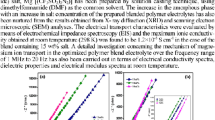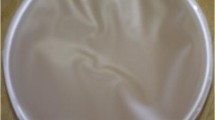Abstract
A series of ion-conducting poly (ethylene oxide)/poly(vinylidene fluoride) [PEO/PVdF]-based solid polymer blend electrolytes derived from the addition of varying amounts of zinc trifluoromethane sulfonate (which is also known as zinc triflate), [Zn(CF3SO3)2] as dopant salt were synthesized in the form of films by solution-casting method. Accordingly, freshly prepared specimens of [90 wt% PEO/10 wt% PVdF + x wt% Zn(CF3SO3)2, where x = 3 to 18 wt% in steps of 3 wt%] were characterized by means of X-ray diffraction (XRD), Fourier transform infrared spectroscopy (FTIR), scanning electron microscopy (SEM) and impedance analysis techniques. The room temperature XRD patterns tend to confirm the formation of an amorphous phase obtained by reducing the crystallinity of the host polymer blend matrix [90 wt% PEO/10 wt% PVdF] as a result of addition of 15 wt% zinc triflate salt. The relevant SEM images of this particular polymer blend electrolyte specimen exhibit a smooth and porous structure when compared to that of the host polymer blend [90 wt% PEO/10 wt% PVdF]. Remarkably, the highest ionic conductivity realized in the case of the typical polymer system [90 wt% PEO/10 wt% PVdF + 15 wt% Zn(CF3SO3)2] is found to be 2.5 × 10−5 S cm−1 at room temperature. The occurrence of ion dynamics and dielectric relaxation behaviour in the chosen system has been analysed in a detailed fashion at room temperature using frequency response impedance formalisms involving electric modulus and dielectric permittivity features.







Similar content being viewed by others
References
Choi JW, Aurbach D (2016) Promise and reality of post-lithium-ion batteries with high energy densities. Nat Rev 16013
Lee JS, Tai Kim S, Cao R, Choi N-S, Liu M (2011) Metal–air batteries with high energy density: Li–air versus Zn–air. Adv Energy Mater 1:34–50
Cheng F, Chen J (2012) Metal–air batteries: from oxygen reduction electrochemistry to cathode catalysts. Chem Soc Rev 41:2172–2192
Rahman MA, Wang X, Wen C (2013) High energy density metal-air batteries: a review. J Electrochem Soc 160(10):A1759–A1771
Wu GM, Lin SJ, Yang CC (2006) Alkaline Zn-air and Al-air cells based on novel solid PVA/PAA polymer electrolyte membranes. J Membr Sci 280:802–808
Mainar AR, Leonet O, Bengoeche M, Boyano I, Meatz ID, Kvasha A (2016) Alkaline aqueous electrolytes for secondary zinc–air batteries: an overview. Int J Energy Res 40:1032–1049
Why a rechargeable zinc battery is such a big deal, https://www.bloomberg.com/news/articles/2013-01-08/
Jing F, Zhang J, Song X, Zarrin H, Tian X (2016) A flexible solid-state electrolyte for wide-scale integration of rechargeable zinc–air batteries. Energy Environ Sci 9:663–670
Yang Y, Zhang J, Zhou C, Wu S, Xu S, Liu W (2008) Effect of lithium iodide addition on poly (ethylene oxide)-poly (vinylidene fluoride) polymer-blend electrolyte for dye-sensitized nanocrystalline solar cell. J Phys Chem B 112:6594–6602
Smitha B, Sridhar S, Khan AA (2005) Solid polymer electrolyte membranes for fuel cell applications—a review. J Membr Sci 259:10–26
Meng C, Liu C, Chen L, Hu C, Fan S (2010) Highly flexible and all-solid-state paperlike polymer supercapacitors. Nano Lett 10:4025–4031
De Paoli MA, Casalbore–Miceli G, Girotto EM, Gazotti WA (1999) All polymeric solid state electrochromic devices. Electrochim Acta 44:2983–2991
Lee HJ, Lim JM, Kim HW, Jeong SH, Eom SW, Hong YT (2016) Electrospun polyetherimide nanofiber mat-reinforced, permselective polyvinyl alcohol composite separator membranes: a membrane-driven step closer toward rechargeable zinc–air batteries. J Membr Sci 499:526–537
Xi J, Qiu X, Li J, Tang X, Zhu W, Chen L (2006) PVDF–PEO blends based microporous polymer electrolyte: effect of PEO on pore configurations and ionic conductivity. J Power Sources 157:501–506
Ikeda S, Mori Y, Furuhashi Y, Masuda H (1999) Multivalent cation conductive solid polymer electrolytes using photo-cross-linked polymers II. Magnesium and zinc trifluoromethanesulfonate systems. Solid State Ionics 121:329–333
Xu JJ, Ye H, Huang J (2005) Novel zinc ion conducting polymer gel electrolytes based on ionic liquids. Electrochem Commun 7:1309–1317
Plancha MJC, Rangel CM, Sequeira CAC (1999) Pseudo-equilibrium phase diagrams for PEO–Zn salts-based electrolytes. Solid State Ionics 116:293–300
Girish Kumar G, Sampath S (2003) Electrochemical characterization of poly (vinylidenefluoride)-zinc triflate gel polymer electrolyte and its application in solid-state zinc batteries. Solid State Ionics 160:289–300
Abrantes TMA, Alcacer LJ, Sequeira CAC (1986) Thin film solid state polymer electrolytes containing silver, copper and zinc ions as charge carriers. Solid State Ionics 18:315–320
Polu AD, Kumar R, Joshi MG (2014) Effect of zinc salt on transport, structural, and thermal properties of PEG-based polymer electrolytes for battery application. Ionics 20:675–679
Sai PCM, Suthanthiraraj SA (2016) Electrical, structural and morphological studies of honeycomb-like microporous zinc-ion conducting poly (vinyl chloride)/ poly(ethymethacrylate) blend-based polymer electrolytes. Ionics 22:389–404
Nancy CA, Suthanthiraraj SA (2016) Preparation and characterization of a new PEO-PPG blend polymer electrolyte system. Ionics 22:2399–2408
Ye H, Xu JJ (2007) Zinc ion conducting polymer electrolytes based on oligomeric polyether/PVDF-HFP blends. J Power Sources 165:500–508
Meyer WH (1998) Polymer electrolytes for lithium-ion batteries. Adv Mater 10:439–448
Quartarone E, Mustarelli P, Magistris A (1998) PEO-based composite polymer electrolytes. Solid State Ionics 110:1–14
Rathika R, Suthanthiraraj SA (2016) Ionic interactions and dielectric relaxation of PEO/PVDF-mg[((CF3SO2)2N2)] blend electrolytes for magnesium ion rechargeable batteries. Macromol Res 24:422–428
Li H, Chao C-Y, Han P-L, Yan X-R, Zhang H-H (2016) Preparation and properties of gel-filled PVDF separators for lithium ion cells. J Appl Polym Sci. doi:10.1002/APP.44473
Yusong Z, Shiying X, Shi Y, Yaqiong Y, Yuyang H, Yuping W (2013) A composite gel polymer electrolyte with high performance based on poly(vinylidenefluoride) and polyborate for lithium ion batteries. Adv Energy Mater. doi:10.1002/aenm.201300647
Koh SN, Ramesh S, Ramesh K, Joon CJ (2016) A review of polymer electrolytes: fundamental, approaches and applications. Ionics. doi:10.1007/s11581-016-1756-4
Senthil Kumar P, Sakunthala A, Govindan K, Reddy MV, Prabu M (2016) Single crystalline TiO2 nanorods as effective fillers for lithium ion conducting PVdF-HFP based composite polymer electrolytes. RSC Adv. doi:10.1039/C6RA20649B
Michael MS, Jacob MME, Prabaharan SRS, Radhakrishna S (1997) Enhanced lithium ion transport in PEO-based solid polymer electrolytes employing a novel class of plasticizers. Solid State Ionics 98:167–174
Gao K, Hu X, Dai C, Yi Y (2006) Crystal structures of electrospun PVDF membranes and its separator application for rechargeable lithium metal cells. Mater Sci Eng B 131:100–105
Costa CM, Machiavello MNT, Ribelles JLG, Mendez SL (2013) Composition-dependent physical properties of poly [(vinylidene fluoride)-co-trifluoroethylene]–poly (ethylene oxide) blends. J Mater Sci 48:3494–3504
Theerthagiri J, Senthil RA, Buraidah MH, Madhavan J, Arof AK (2015) Effect of tetrabutylammonium iodide content on PVDF-PMMA polymer blend electrolytes for dye-sensitized solar cells. Ionics \:2889–2896. doi:10.1007/s11581-015-1464-5
Sownthari K, Suthanthiraraj SA (2013) Synthesis and characterization of an electrolyte system based on a biodegradable polymer. eXPRESS Poly Lett 7(6):495–504
Pereira N, Costa CM, Méndez L (2015) Polymer materials for energy and electronic applications. J Power Sources 281:378–398
Prabakaran P, Manimuthu RP (2016) Enhancement of the electrochemical properties with the effect of alkali metal systems on PEO/PVdF-HFP complex polymer electrolytes. Ionics 22:827–839
MacFarlane DR, Meakin P, Bishop A, McNaughton D, Rosalie JM, Forsyth M (1995) Ftir study of ion-pairing effects in plasticized polymer electrolytes. Electrochim Acta 40:2333–2337
Suthanthiraraj SA, Kumar R, Paul PJ (2009) FT-IR spectroscopic investigation of ionic interactions in PPG 4000: AgCF3SO3 polymer electrolyte. Spectrochim Acta A 71:2012–2015
Tafur JP, Antonio J, Romero F (2014) Electrical and spectroscopic characterization of PVdF-HFP and TFSI - ionic liquid-based gel polymer electrolyte membranes. Influence of ZnTf2 salt. J Membr Sci 469:499–506
Baskaran R, Selvasekarapandian S, Hirankumar G, Bhuvaneswari MS (2004) Vibrational, ac impedance and dielectric spectroscopic studies of poly(vinylacetate) - N,N - dimethylformamide -LiClO4 polymer gel electrolytes. J Power Sources 13:235–240
Juan P, Guisao, Antonio J, Romero F (2015) Interaction between Zn2+ cations and n-methyl-2-pyrrolidone in ionic liquid- based gel polymer electrolytes for Zn batteries. Electrochim Acta 176:1447–1145
Jonscher AK (1983) Dielectric relaxation in solids. Chelsea Dielectrics, London
Kumar R, Suthanthiraraj SA (2014) Ion dynamics and segmental relaxation of CeO2 nanoparticles loaded soft-matter like gel polymer electrolyte. J Non-Cryst Solids 405:76–82
Noto VD, Vittadello M, Lavina S (2001) Mechanism of ionic conductivity in poly (ethyleneglycol 400) / (LiCl) x electrolytic complexes: studies based on electrical spectroscopy. J Phys Chem B 105:4584–4595
Ramesh S, Arof AK (2001) Ionic conductivity studies of plasticized poly (vinyl chloride) polymer electrolytes. Mater Sci Eng B 85:11–15
Kumar R, Suthanthiraraj SA (2014) Segmental mobility and relaxation processes of Fe2O3 nanoparticle-loaded fast ionic transport nanocomposite gel polymer electrolyte. J Solid State Electrochem 18:1647–1656
Fu Y, Pathmanathan K, Stevens JR (1991) Dielectric and conductivity relaxation in poly (propylene glycol)–lithium triflate complexes. J Chem Phys 94:6323–6632
Acknowledgements
One of the authors (R.R.) greatly acknowledges the University of Madras for the award of University Research Fellowship (URF). The authors would also like to thank the National Centre for Nanoscience and Nanotechnology, University of Madras, for providing the necessary experimental facilities for SEM analysis.
Author information
Authors and Affiliations
Corresponding author
Rights and permissions
About this article
Cite this article
Rathika, R., Padmaraj, O. & Suthanthiraraj, S.A. Electrical conductivity and dielectric relaxation behaviour of PEO/PVdF-based solid polymer blend electrolytes for zinc battery applications. Ionics 24, 243–255 (2018). https://doi.org/10.1007/s11581-017-2175-x
Received:
Revised:
Accepted:
Published:
Issue Date:
DOI: https://doi.org/10.1007/s11581-017-2175-x




